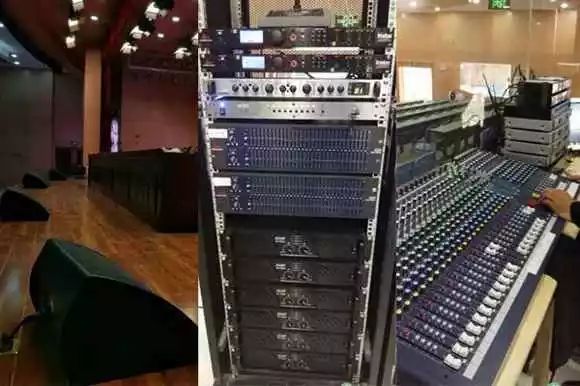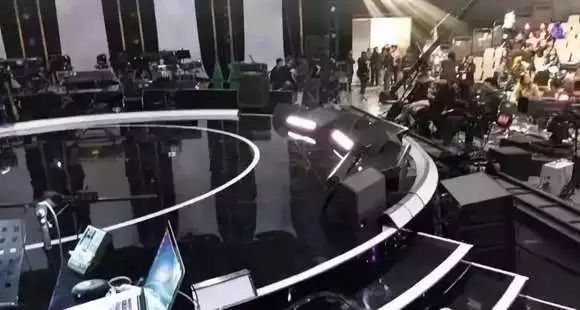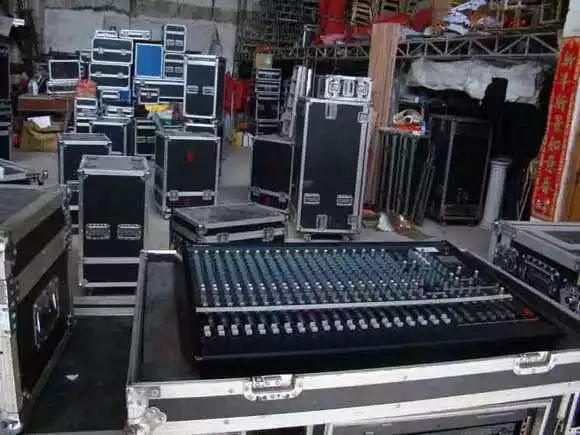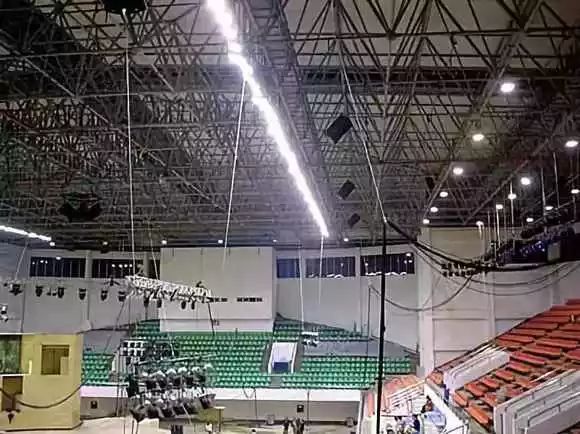The distribution of audio power is very important; if not handled well, the main speakers, return monitoring, and listening can have disagreements!
1. Power Distribution of the Main Sound System
The power distribution of the main sound system for amplification should be based on the determined number of combinations, selecting an appropriate number according to the distortion-free power conditions of the power amplifier. For driving the speakers, a preamplifier crossover method or a power crossover method can be used. To ensure the rationality and reliability of the speaker system in the hall, special handling is required in the grouping and wiring technology of power distribution.
In large halls, to give the speaker system a better sense of direction, it is best for the audience to 'see' the speakers, making the visual and auditory positions basically consistent. This is because the horizontal sense of direction is more sensitive for hearing, while the vertical sense of direction is relatively less clear.
If an appropriate delay is inserted into the main speaker system, utilizing the Haas effect to lower the sound image, making the speaker system's position more aligned with the sound source, the listening effect will be further improved.
Auxiliary speaker systems outside the main speaker system generally have different types, such as ceiling speakers for background music in corridors and lounges, and combination speakers or small sound columns in small VIP meeting rooms.
At this time, appropriate grouping should be done based on the power, impedance (or voltage), and quantity of the selected speakers, and necessary parallel and series processing should be done before connecting to the power distribution board. Based on the overall power distribution situation, design a connection circuit that can switch with the power amplifier, and select a backup amplification system to facilitate control and operation in the amplification control room. Additionally, the power of the return listening system and monitoring system should also be determined.

2. Return Listening System and Required Power
The return listening system is a sound system specifically established to solve the hearing issues of actors and the band on stage. During performances, actors and the band are located behind the main sound field speakers. If they cannot hear their own vocal effects clearly, they cannot find the right performance feeling. Therefore, for the sound systems in theaters and dance halls, the return listening system is also essential in addition to the main sound field system.
Moreover, when the main sound field system malfunctions, the return listening system can also serve as an emergency sound system to avoid a cold scene. In general situations, the power of the return listening system is taken as 20% of the main sound field power. For example, if the main sound field power is 2000w, then the power of the return listening system should be selected as 400w.
In the return listening system, to ensure the return listening volume is appropriate and the effect is clear, the power of the return amplifier should be about 1.3 times greater than the power of the return speakers. In actual use, the output power of the return amplifier should also be adjusted on-site. If the power of the return listening system is too small, it will lose its meaning; if the power is too large, it will overshadow the main sound and easily cause adverse effects of sound feedback. Therefore, special attention should be paid to the adjustment of the volume and effect of the return listening system.
3. Monitoring System and Required Power
The monitoring system is a sound system specifically established to solve the hearing issues of sound operators in the control room. During performances, the main speakers are located in the main sound field, which is soundproofed from the control room, preventing sound operators from directly hearing the effects of the main speakers and their own adjustments, making it impossible to work.
Therefore, it is necessary to install a monitoring system in the control room that is synchronized with the main sound field sound, helping sound operators understand the sound effects of the main sound field for timely adjustments. Thus, the monitoring system is also essential for sound systems in various halls.
In general situations, the power of the monitoring system is taken as 10% of the main sound field power. For example, if the main sound field power is 2000w, then the power of the monitoring system can be selected as 200w. In the monitoring system, to monitor without distortion, the power of the monitoring amplifier can be equal to the power of the monitoring speakers.
In actual use, the output power of the monitoring amplifier should also be adjusted on-site. If the power of the monitoring system is too small, it will lose its meaning; if the power is too large, it will make the control room too noisy, affecting the work of sound operators. Therefore, the monitoring system should be adjusted to an appropriate volume before the program starts.
The total power of the subwoofer can be taken as 0.5 to 1.5 times the total power of the main speakers. The upper limit should be taken for disco dance floors, while the lower limit can be taken for multifunctional halls; in cases limited to speech amplification, subwoofers may not be configured.
Other surround speakers, such as rear speakers and feedback speakers, can have power taken as 1/10 to 1/2 of the main speakers (for AC-3 systems, the surround speakers are required to match the main speakers).

4. System Selection
In amplification sound systems, the quality of sound entirely depends on the good working condition of every link in the entire sound system equipment. The performance of the equipment is an important indicator of whether the entire system can work with high quality and stability. Therefore, the selection of the sound system is as crucial as the design of sound field quality and amplification system design.
The amplification forms of professional sound systems include monaural amplification, stereo amplification, and surround stereo amplification. Only after the amplification form is determined can the equipment selection for the sound system be carried out.
Monaural Amplification
Monaural amplification is currently the main form of amplification in domestic halls. This form of amplification has advantages such as simple system structure, low investment, and ease of control.
Depending on the specific situation of the amplification system, sometimes there is no need to consider having stereo amplification functionality. In this case, half of the peripheral equipment, such as room equalizers, limiters, and delay devices, can be used in a single channel (monaural), which often reduces costs. This solution is an economical and practical design for venues and auditoriums primarily used for speech amplification.
Stereo Amplification Form
The unity of sound image, clarity, and layering of stereo amplification form is superior to that of monaural amplification form. In practical applications of electric sound systems, 70mm cinemas often use stereo playback systems to achieve a high degree of unity between sound image and visual image, creating a realistic sense of three-dimensionality and space.
However, for most theaters and auditoriums in the country, currently only a few adopt stereo standards. Because in theaters and auditoriums that use stereo amplification, not all seats can hear perfect stereo sound effects. In many theaters and auditoriums with stereo amplification, the sound effects in certain seats are often worse than when using monaural.
The reason for the above phenomenon is that the effective listening area of stereo sound in a dual-channel system is not large. In halls using stereo amplification, to ensure that all audience members can fully enjoy the stereo effect, the number of seats may need to be greatly reduced, making the design of the hall, the layout of the speakers, and the operation of the sound control more difficult.
When the original design does not consider using stereo amplification in the hall, the effect is often counterproductive. The result may be that a small number of audience members experience a complete stereo effect, while the majority do not perceive the superiority of stereo sound at all.
From the perspective of audio equipment, modern electric sound devices generally have the basic functions of stereo sound. As the core device of the electric sound system, the mixing console typically has the most basic stereo functions, including a 'sound image (panorama)' potentiometer and stereo outputs for left and right channels, so other devices, amplifiers, and speakers are also configured for left and right channels to enable stereo amplification.
The design of some older halls often fails to meet the requirements for stereo amplification. The usual practice is to place the 'sound image (panorama)' on the mixing console in the center position, and the stereo equipment is downgraded to mono equipment for use.
In other words, the current design of electric amplification sound systems often adopts the following form: ensuring that the equipment has the basic functions of stereo amplification; but considering the specific situation of the hall's environmental structure and seating arrangement, to ensure a large area of sound effect, generally only mono amplification is used. This is also true for most dance halls' electric sound systems.
Many dance halls and multifunctional halls generally adopt the above plan, that is, retaining stereo functions in equipment configuration, but only using mono amplification in practice. Since the design requirements for dance halls and multifunctional halls do not have a unified model, the amplification methods used should also be flexible.
For example, a combination of stereo and mono can be used, where stereo amplification is applied in areas like the VIP seats and dance floor, while other areas use mono amplification. The general principle is: as long as all listening areas can hear complete program information, avoid interference effects caused by too many speakers and irregular placement.
Surround stereo sound
This enhances the sense of stereo and spatial perception based on ordinary dual-channel stereo, and is a high-level amplification form. It has been installed in some newly built cinemas and theaters in the country.

5. Equipment selection
Speakers
Speakers are the voice of the entire sound system, so they should be considered as a primary factor. The selection of speakers should start from their sensitivity and rated power to determine the power of each sound source. Analyze and control the hall's sound field based on the directivity of the speakers, determine the position of each speaker, input impedance, and input power, and calculate the matching power between the speakers and the power amplifier.
Power amplifier
To ensure the overall sound quality effect of the amplification system, the power amplifier must have sufficient power reserve and be able to work stably for a long time. At the same time, the selected amplifier should have complete technical measures in terms of improving efficiency, reducing distortion, short-circuit and no-load protection, and lowering temperature rise.
Mixing console and other equipment
The mixing console is the heart of the entire sound system. It should have good electrical performance, stable working conditions, flat frequency response, and minimal harmonic distortion. There are significant differences in the functions of mixing consoles, so the selection should be based on the functional requirements of the entire system to choose the appropriate number of input channels and output groups.
In addition, suitable equalizers can be selected based on the acoustic requirements of different halls. Devices such as delay units, reverberators, compressors, and frequency shifters form a normal, stable, and reliable amplification sound system.
Program source equipment
The program source part includes the reception and relay of FM and AM broadcasts, playback equipment for records (including CDs) and tapes. Since the input level of the program source part is low, all components and devices must ensure high sensitivity, large signal-to-noise ratio, low distortion, and good reliability.
Microphone selection
The microphone is the first 'entry' of the amplification system. The natural sound source signal is converted into an electrical signal by the microphone, and the output voltage is processed and amplified through the mixing console and power amplifier, feeding into the speaker system, with amplification factors reaching tens of thousands.
The performance of the microphone directly affects the quality of the system; the characteristics of the microphone itself directly influence the system's pickup and playback effects; the correct placement of the microphone directly affects the system's transmission gain; the signal connection of the microphone directly affects the system's signal-to-noise ratio. Proper use of the microphone is one of the keys to keeping the entire audio system in good working condition.
The selection of microphones must be compatible with the acoustic environment and the sound source being picked up. It should be weighed based on the overall requirements of the amplification system, application scenarios, sound sources, the technical characteristics of the microphone itself, and the characteristics of the hall.

6. Pipeline design
For fixed installation sound systems, the signals from microphones and electric musical instruments on stage must be sent to the sound control room via cables, and the amplifier output must be sent to the speaker system via cables. These cables should be laid in conduits.
Iron pipe installation
It should be noted that the issue of conduit installation for microphone input lines and speaker output lines outside the control room. Although the signal lines used in electric sound engineering are all metal braided shielded lines, for the installation of fixed equipment, whether in concealed or exposed conduit wiring, it is best to use iron pipes.
The benefits of using iron pipes are:
1. Cables are protected by iron pipes, preventing damage.
2. Prevent interference from spatial electromagnetic fields, providing good shielding effects.
3. The conduit work can be done in advance, and the wiring can be done last, which is very convenient, and replacing the cable group is also easier. In newly built and renovated halls, to ensure the undistorted transmission of signals, pipeline design is also very important.
Key points of pipeline design
In order to reduce induced noise during transmission, microphone input lines often use double-core shielded cables and must be routed through metal pipes. For particularly long transmission routes, special attention should be paid to keeping the wiring away from power transmission cables and avoiding parallel routing with them.
At the same time, the connections between the pipe joints and the wiring junction boxes must be handled well. The position of the microphone will always change, so during the design phase, multiple junction boxes should be prefabricated, each capable of accommodating a certain number of XLR sockets. Then, based on usage, they can be installed in appropriate locations, such as inside the walls on both sides of the stage, in front or under the floor where the band is located, and under the podium and referee's table in the gymnasium. All junction boxes should be embedded for convenience.
For speaker connections, to ensure output power and the damping match between the amplifier and the speaker, it is sufficient to choose thick enough wires and lay them in pipes. For the main speaker system, to ensure reliability, a ring jump method can be used for grouped wiring. This way, if any point in a group of speakers has a broken line, the entire main speaker system can still operate normally.
Once the location of the sound amplification control room, the position of the microphone socket junction box, and the layout of the speaker system are determined, an economical and reasonable design for the sound amplification system pipeline can be made based on the structure of the building, avoiding strong electrical interference, and a construction plan can be drawn up.
7. Pipeline Laying Process
When laying pipelines, the following issues should be noted:
(1) Lighting cables and audio cables should be laid in separate pipes and kept at a certain distance. When laid in parallel, the distance should be more than 1 m. When crossing each other perpendicularly, the distance should also be more than 0.5 m. It is best to avoid parallel wiring.
(2) When three or more cables are passed through one pipe, the total cross-sectional area of the wires should not exceed 40% of the cross-sectional area of the iron pipe. When two cables pass through the same iron pipe, the inner cross-sectional area of the iron pipe should be greater than 1.2 times the cross-sectional area of the cables.
(3) To facilitate wiring, the length of straight pipe laying should not exceed 50 m; for one to two bends, the length should not exceed 30 m; for three to four bends, the length should not exceed 15 m. If the above lengths are exceeded, junction boxes should be added in between to facilitate segmental wiring.
(4) Iron pipes must be grounded; otherwise, they will cause interference. All iron pipes and junction boxes must be connected into a whole and grounded, which is very important.
WEISHITE Audio Technology (Guangzhou) Co., Ltd
Address: 5th Floor, No. 11, Area A5, Lixin Road, Huimei New Village, Xintang Town, Zengcheng District, Guangzhou City
E-mail :caoyaoyu@gztsaudio.com

@2025 WEISHITE Audio Technology (Guangzhou) Co., Ltd All rights reserved

